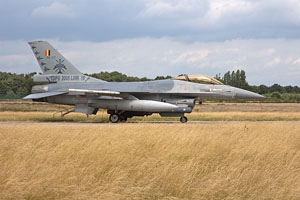
|
Operational Integration Exercise Kleine Brogel, Belgium 18-21 July 2005
|
|
The French delegation was particularly heavy, with a pair of these air defence tasked Mirage 2000RDI's from EC 1/12 "Cambresis" from Cambrai. Apart from this, there where a pair of Mirage F.1CR's from ER 1/33 "Belfort" from Reims for recce work. Unconnected with the OpInt exercise where a quartet of trainers visiting Kleine Brogel, these being two Alpha Jets from GE 314 from Tours and two Tucanos from Salon de Provence. |
|
Attack configured aircraft detached to Kleine Brogel by the Armée de l'Air included a trio of Nancy based Mirage 2000D's alongside this single EC 2/4 "La Fayette" Mirage 2000N. Note the SPA 160 "Diable Rouge" badge on the fin of this aircraft. |
|
Not to be outdone by their land dwelling Air Force counterparts, the Aeronavale presence was also quite impressive. No fewer than four Super Etendard Modernise fighter bombers took up temporary residence at Kleine Brogel. This example is from Flotille 11F, normally based at Landivisiau in Brittany but deployable to the aircraft carrier FNS Charles de Gaulle. |
|
From the same base at Landivisiau came a pair of the brand-new Dassault Rafale M air superiority fighters. The Rafale has been operational with the French navy for only a few years and was quite badly needed as it replaced antiquated F-8P Crusaders. Like the Crusaders, the Rafales are being flown by Flottile 12F from Landivisiau but deploy to the carrier Charles de Gaulle on occasions. |
|
Joining the French coningent in an exclusive air-to-air role during the exercise were a trio of Swiss Air Force F/A-18 Hornets. among them were two F/A-18C single seaters like J-5008 and an F/A-18D two seater. The Swiss only use their Hornets in an air defence configuration |
|
From the very new to the very old; the Greek contingent was made up of a pair of Vought A-7 Corsairs. The Hellenic Air Force had combined their participation in the exercise with a visit to the Royal International Air Tattoo at RAF Fairford, UK. The 116 PM at Araxos operates all the survivors of the original batch of A-7H/TA-7H built for Greece as well as the ex-US Navy A-7E/TA-7C's. 160736 to the left is one of those second hand A-7E's which was accompanied by a TA-7C. |
|
Once one of the Warsaw Pacts mightiest formations, the nowaday's Czech Republic Air Force is substantially smaller. Two main combat types are being flown by the Air Force now that the MiG.'s have gone. One of those two types is the indeginously built Aero L.159 ALCA (Advanced Light Combat Aircraft) flown by Caslav's 211 Lt, two of which took part in OpIntEx. |
|
The German Luftwaffe's delegation to OpIntEx consisted of Tornados from four different wings. This one, 45+45 with JBG 31 at Norvenich, is of note because it used to belong to the now disbanded German Navy's MFG 2. Note the naval camouflage applied to this jet as wel as the light circle in front of the serial number where the Navy's anchor badge used to be. The Luftwaffe took over the Navy's tasks earlier this year. |
|
Another type due to disappear from the skies shortly is the English Electric Canberra. This PR.9 is one of the final examples on the strength of No. 39 (1 PRU ) sq at RAF Marham and is seen here during a low level high speed pass prior to flying back to the UK. |
|
Unconnected with OpIntEx entirely, but at Kleine Brogel for all to see nevertheless was a.o. this single Polish Su.22UM-3 two seater trainer. 6 elt (6.Eskadra Lotnictwa Taktycznego, Tactical Squadron) is the proud owner of this Tiger marked Fitter-G. |
|
Like so many other Eastern European air forces, the Polish Air Force is gradually changing to Western designed types. In the transport squadron, 13 eltr (13.Eskadra Lotnictwa Transportowego), the place of the Antonov An.26 is being taken by the Spanish CASA C.295M. One example could be seen at Kleine Brogel, no doubt supporting the Su.22UM-3 on it's return flight to Powidz. |
|
The Romanian Air Force may at first glance be sticking to Soviet supplied types, but the innards of this MiG.2MF have been greatly modernised turning this aircraft into a Lancer-C. Lots of Israeli equipment went into the Lancer, keeping this type viable for a number of years. The Romanians had been taking part in a squadron rotation at RAF Lossiemouth. No fewer than four Lancers staged through Kleine Brogel on their way back to Baza 86, Borcea-Fetesti. |
|
In this, they could rely on the transport services from this Antonov An.26 from Baza 90 at Bucharest. This concludes a brief overview of what visitors to the 7th International Spotter's Day at Kleine Brogel were shown. Our Belgian hosts are to be thanked and complimented for this opportunity, especially in the light of recent events. |
All pictures (c) Hans Rolink